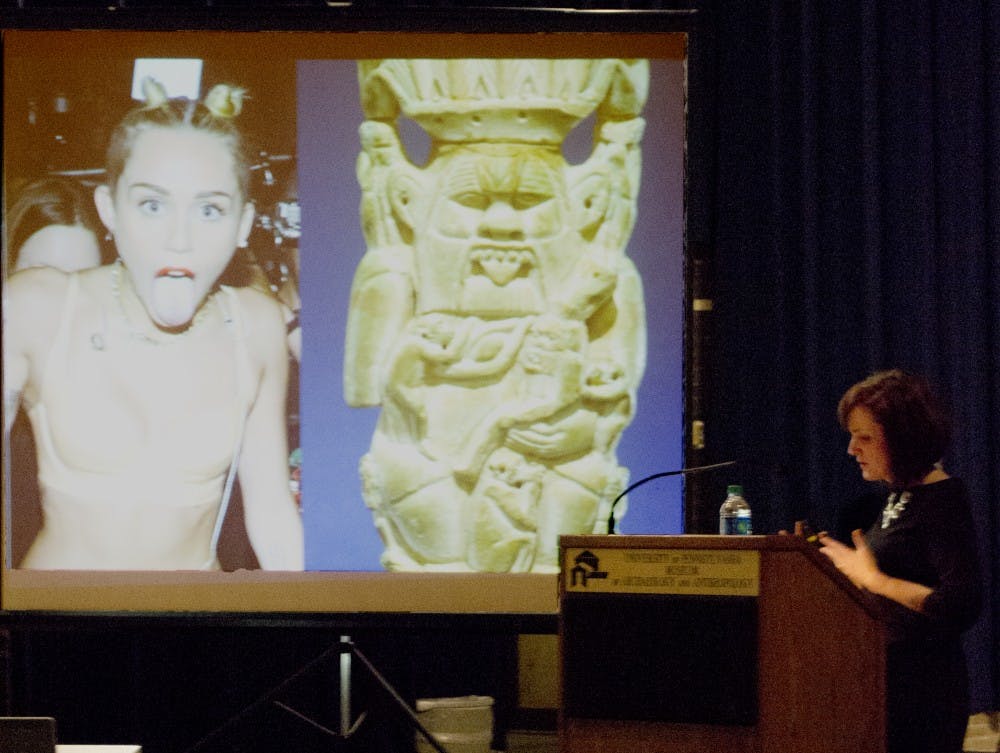Even 3,000 years ago, people were kinky.
Last night, the University of Pennsylvania Museum of Archaeology and Anthropology hosted its annual Valentine’s Day presentation, this year called “Blurred Lines,” sponsored by the Young Friends Society. The event, which was rescheduled from Feb. 13 , didn’t suffer in attendance - more than 50 people sat in the audience in the Egyptian gallery.
Surrounded by dozens of artifacts, each thousands of years old, professors Jennifer Wagner and Brian Rose took turns discussing different artifacts and myths from Egypt and Greece, respectively. But this wasn’t just a normal talk. Each story and image projected on the screen detailed the “blurred lines” of sexuality in ancient Egypt and Greece. From winged penises to hermaphrodites to wind chimes made out of dildos, the professors spoke intimately about how sexuality was portrayed in the ancient world.
“I always love it when we get asked to do these kinds of talks,” Wagner said as she took the podium. “They force us to look at these objects and these cultures in new ways. I’ve worked with and studied these societies for years, but it’s not every day that I get to look at ancient phalluses and fertility symbols ... I just hope the University doesn’t find my search history!”
The audience chuckled as Wagner showed images of ancient papyrus scrolls that make up a sex manual of sorts. She referenced an ancient myth about a creator god whose masturbation led to the birth of lower Egyptian gods.
In keeping with the “blurred lines” theme, though, she didn’t just detail sexually explicit objects. Wagner also examined their cultural implications. For ancient Egyptians, sexual imagery was a symbol of rebirth and prosperity, and they were sometimes even used as political commentary or a method of passage into the afterlife.
One object in particular was almost an ancient and explicit version of a modern political cartoon. Drawn at the bottom of a political text, an artist depicted the infamous Egyptian pharaoh, Hatshepsut, having sex with her male servant. Hatshepsut was known for disguising herself as a man.
When it was Rose’s turn to speak, he highlighted a few objects in the Penn Museum’s own collection, including a series of bronze amulets shaped like phalluses. He laughed along with the audience as he showed images of men with grossly enlarged penises, a common depiction in ancient Greek art. He also showed humanoid figures having sex with different animals.
Rose even described the ancient city of Sardis as the “center of dildo manufacturing” in ancient Greece. But, like in ancient Egypt, sexual images often had a deeper meaning .
“It was very common to see phalluses in the home in ancient Greece,” Rose said. “An image of an erect phallus was a symbol of prosperity and procreation. It was seen as a way to demonstrate a family’s success and even a way to keep evil spirits away.”
After the event, attendees stayed to enjoy a cash bar and an optional tour offered by the professors to look at some of the sexual objects described in the talk.
“We’re really happy with the turnout this year, especially given the postponement,” Emily Goldsleger, assistant director of membership and annual giving at the museum , said . “We love doing these events because they attract such a broad audience.”
With this event, the museum hoped to attract a younger audience. “Human sexuality is something that everyone can relate to,” Goldsleger said.



